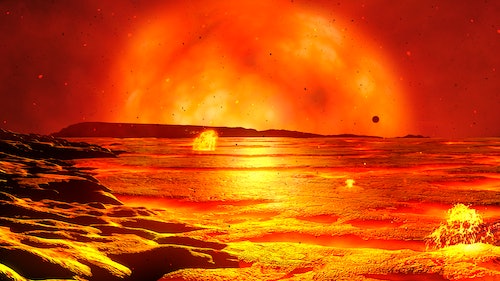Gas giant Halla should have been swallowed up by its red giant star, Baekdu, but fate intervened. Astronomers may have just found the luckiest planet in the universe. Someday our friendly yellow Sun will turn a baleful red and swallow up the inner Solar System.
Eventually, it will cool and shrink again, but by then, Earth and our rocky neighbors will be long gone. In 2015, astronomers discovered a planet that seems to have survived the enormous expansion of its star, but a recent study suggests that there’s more to this strange planet than meets the eye. University of Hawai’i astronomer Marc Hon and his colleagues published their work .
In about 5 billion years, the Sun will swell outward and swallow not only Earth, but all the rocky little worlds of the inner Solar System. The gas giant Halla, also known as 8 Ursae Minoris b, zips around its aging red giant star once every 93 days, at just half the distance between Earth and our Sun. That’s close enough to make Halla an uncomfortably warm place to be, but it also makes Halla’s existence a huge surprise to astronomers.
Halla’s star, a red giant called 8 Ursae Minoris or Baekdu, is burning helium in its core. That means that at some point in its past, it ran out of hydrogen atoms to fuse into helium. Changes in energy and pressure deep inside the star eventually led to a layer of hydrogen burning outside the core; the heat from this layer of burning hydrogen caused the star’s outer layers to swell, ballooning outward to well past Halla’s orbit.
At that point, Baekdu’s tidal forces should have as the planet fell toward the star’s center. We’ve . Eventually, Baekdu’s core would have started fusing helium into carbon, and the star would have slowly cooled and shrunk back toward its current size.
But no planet should have survived the process. So what happened? Hon and his colleagues have a couple of ideas, and they both involve dramatic collisions between stars. They suggest that Baekdu was once part of a , like the twin suns of Tatooine in Star Wars (or, in the real universe, like Alpha Centauri A and B just four light years away from us).
At some point in the past, the two stars spiraled closer and closer together until they finally merged, forming the Baekdu astronomers see today. Computer simulations suggest that when that happens, especially between a red giant like Baekdu and a white dwarf (the remains of a star that burned up all its fuel but wasn’t big enough for a supernova), the merger can kickstart the process of burning helium in the larger star’s core. When that happens, it stops the red giant from bloating outward.
In other words, a stellar cataclysm may have spared Halla from certain doom. The other possibility is that Halla is actually a product of that stellar cataclysm, not just a lucky bystander. Hon and his colleagues say the planet could have coalesced from the cloud of gas blown out into space during the collision between the two stars.
Either way, Halla didn’t actually survive being swallowed up by a red giant — which means our Earth is probably still doomed in about 5 billion years. .
From: inverse
URL: https://www.inverse.com/science/a-stellar-cataclysm-saved-this-planet-from-destruction



